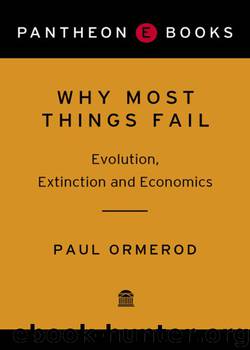Why Most Things Fail by Paul Ormerod

Author:Paul Ormerod
Language: eng
Format: epub
Tags: Nonfiction
ISBN: 9780307430236
Publisher: Knopf Doubleday Publishing Group
Published: 2007-12-17T16:00:00+00:00
FIGURE 7.1 Customers evenly spread along the beach in the Hotelling location model/game. Locations designated by points between 0 and 100
However, a moment’s reflection will convince us that this solution is not a stable one. Suppose the sellers do start off at the 25 and 75 combination of points. They observe the patter of feet and procession of customers to their stalls. It might quickly occur to the vendor at point 75, say, that by trundling his cart just to the right of point 25, he could capture almost three quarters of the total market. All the consumers to the right of his or her new location will buy from there. But then the seller at point 25 could jump just to the right of where its rival has moved, and so on and so forth. In more realistic examples there may, of course, be substantial costs associated with a move. In particular, it may be difficult to reposition a brand, whether in consumer markets or politics, too much. It is a very tricky task to retain the loyalty of a sufficient number of existing consumers and at the same time make the offer so different that it taps into a new part of the market entirely. We will see, however, that even keeping out such complications rapidly leads to very complex situations in the Hotelling location model.
From the perspective of the sellers, as they chase each other along the beach, the unequivocally best location for both of them is exactly halfway, at point 50. Each will continue to get half the market, as they would at points 25 and 75. But in this case neither can outmanoeuvre the other to a superior location. The customers may not be best pleased, because their collective travelling time has increased. Those at the very end of the beach, for example have to travel 50 units of distance, whilst half of the total number of customers now have to walk more than 25 units, the maximum distance anyone has to go at the original 25 and 75 locations. But if they want an ice cream, there is nowhere else to go.
So in this case we can happily collect our fee, safe in the knowledge that our advice to locate right in the middle generates the maximum possible sales for our company. Though it might not be as easy as all that. We are already making many simplifications, some of them quite drastic, which may well not hold in practice. Any real-life decision is therefore bound to be more complicated. Suppose, for example, we allow consumers to start to take into account the costs of travelling to a location. The further a customer has to travel, the greater the inconvenience. Again, this applies not just to physical location. In a political contest, for example, in which there were just two mainstream parties each with a centrist offer, voters with more extreme views may not bother to vote at all. The effective distance between their own preferences and what is on offer means that they do not participate in this particular market.
Download
This site does not store any files on its server. We only index and link to content provided by other sites. Please contact the content providers to delete copyright contents if any and email us, we'll remove relevant links or contents immediately.
International Integration of the Brazilian Economy by Elias C. Grivoyannis(85204)
The Radium Girls by Kate Moore(11857)
Turbulence by E. J. Noyes(7888)
Nudge - Improving Decisions about Health, Wealth, and Happiness by Thaler Sunstein(7450)
The Black Swan by Nassim Nicholas Taleb(6937)
Rich Dad Poor Dad by Robert T. Kiyosaki(6307)
Pioneering Portfolio Management by David F. Swensen(6164)
Man-made Catastrophes and Risk Information Concealment by Dmitry Chernov & Didier Sornette(5870)
Zero to One by Peter Thiel(5629)
Secrecy World by Jake Bernstein(4588)
Millionaire: The Philanderer, Gambler, and Duelist Who Invented Modern Finance by Janet Gleeson(4283)
Skin in the Game by Nassim Nicholas Taleb(4118)
The Age of Surveillance Capitalism by Shoshana Zuboff(4111)
The Money Culture by Michael Lewis(4016)
Bullshit Jobs by David Graeber(3982)
Skin in the Game: Hidden Asymmetries in Daily Life by Nassim Nicholas Taleb(3863)
The Dhandho Investor by Mohnish Pabrai(3628)
The Wisdom of Finance by Mihir Desai(3599)
Blockchain Basics by Daniel Drescher(3422)
